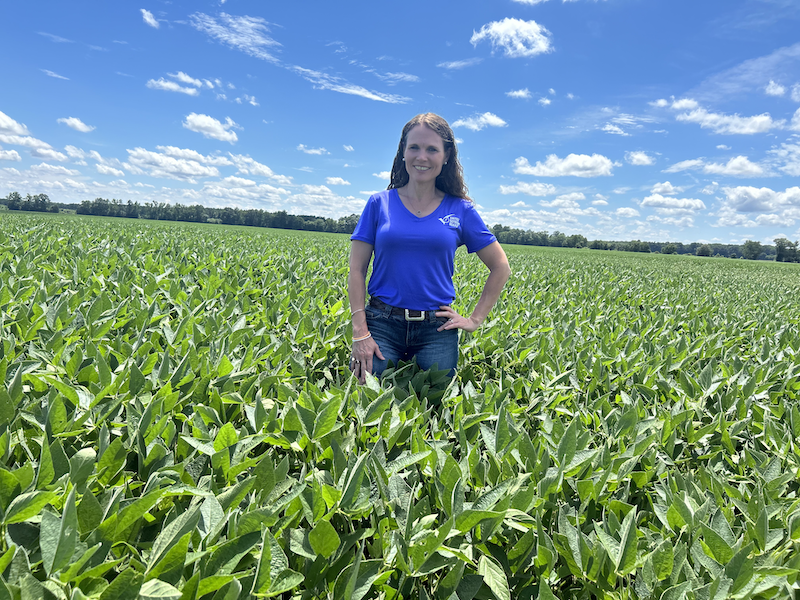
U.S. Soy farmers use sustainable solutions to meet our growing populations' needs, producing essential nutrients while using fewer natural resources.
NORTHAMPTON, MA / ACCESSWIRE / April 8, 2024 / With a growing global population driving an increased need for quality protein, soybeans are emerging as a sustainable solution. While we'll need an additional 3 billion bushels of soybeans per decade to meet increased demand, U.S. soybean farmers are up for the challenge - they're committed to developing and implementing solutions to feed a growing population sustainably.
As stewards of the land, U.S. soybean farmers work to provide quality ingredients for animal feed and food, while also improving and preserving the soil on their farms for future generations. Some 95 percent of soybean producers partner with the U.S. Department of Agriculture to implement conservation programs on their farms.
This means they regularly employ tried-and-true practices such as crop rotation, cover crops and no-till farming, which increase the amount of carbon in our soil - rather than the atmosphere - through carbon sequestration. Combined with GPS-based technology that improves the precision of seed planting and spraying, U.S. soybean farmers' practices improve energy efficiency, maintain soil health and maximize the consistent quality of their harvests.
By 2025, U.S. soybean farmers are committed to:
- Reducing total greenhouse gas emissions by 10 percent (measured as pounds CO2-equivelent gasses emitted per year)
- Increasing energy efficiency by 10 percent BTUs per year
- Reducing land use impact by 10 percent (measured as acres per bushel)
- Reducing soil erosion an additional 25 percent (measured as acres per bushel)
U.S. soybean farmers have been innovating sustainable solutions that benefit the environment and their communities for decades. They have already reduced greenhouse gas emissions by 41 percent per ton and reduced energy usage per bushel by 35 percent since 1980.
Promoting sustainability with no-till farming
No-till farming is one way soybean farmers can embrace sustainability. This is when they don't disturb the soil through tillage which decreases erosion, builds healthier soils and allows earthworms to thrive.
"Even though we may farm differently, U.S. soy farmers want to leave our land in a better condition than when we found it," said Shannon Tignor Ellis, a United Soybean Board (USB) farmer-leader, who serves on the United Soybean Board, and runs her family farm in Virginia that puts these sustainable practices into action. Since the 1980s, Tignor's family farm in the Chesapeake Bay Watershed has practiced no-till farming.
On Tignor's farm, they use cover crops, grass waterways and buffers to protect the soil and prevent run-off. They also retain the biodiversity of the marsh areas, with the addition of the forest and crop land on their farm. Their goal is to be as efficient as possible with inputs of water, seeds, fertilizers and crop protectants.
"We're deeply passionate about caring for the environment, and we take pride in producing a sustainable crop that supports future generations," said Tignor.
Technology also plays a pivotal role in sustainable farming. U.S. soybean farmers such as Tignor use tools such as GPS-enabled tractors and drones and satellite imagery and more to produce more soy from the same amount of land and reduce the use of natural resources. They also use biotechnology to reduce the use of herbicides and decrease weed and insect pressure. Use of technology contributes to increased yields of high-quality soybeans, while optimizing the land more sustainably.
Efficient land, water and energy use from U.S. soybean farmers across the country reduce greenhouse gas emissions and increase soil health. In fact, soybean farmers have improved energy use efficiency by 46 percent and reduced greenhouse gas emissions per bushel by 43 percent. These sustainable practices help better our world while keeping food on tables.
"We want to create a world where soy is a fundamental ingredient in solving the broad challenges of humanity, whether it's providing food security or sustainable products," said Tignor.
New technology creates better environmental outcomes
Looking to the future, U.S. soybean farmers are dedicated to meeting the needs of the growing population through constant innovation.
U.S. soybean farmers leverage technology to decrease pesticide use through targeted application. They have tapped drones to deliver and apply herbicides to control weeds, fungicides to fight disease or other inputs just where they are needed in fields.
They also use autosteer tractors, which allows them to avoid overlapping rows and improves accuracy of application for fertilizer and other inputs. Ultimately, this process creates less waste and allows farmers to streamline the process.
Shannon's farm uses variable rate technology as well as grid-based soil sampling and yield data to create maps that allow her to apply the right amount of nutrients combined with the ideal seeding rate in each zone. Each piece of equipment is outfitted with the corresponding equipment to allow her to use this valuable sustainability tool that boosts efficiency and helps protect the environment.
More food with fewer resources
U.S. soybean farmers work tirelessly to protect and conserve the land. Through sustainable farming, persistent innovation and unmatched efficiency, they consistently produce more essential nutrients while using fewer finite natural resources.
For food companies, this means U.S. grown soy can help meet consumer demand for sustainable and affordable ingredients. Pointing out the sustainability of products with labels such as theSustainable U.S. Soy mark - which recognizes U.S. grown soy ingredients as sustainable ingredients for any food industry formulation - benefits farmers, consumers and processors alike. Highlighting the sustainability of their products not only helps organization's meet their sustainability goals, but also keeps up with consumer demand for sustainable, U.S. grown fats and oils.

Shannon Tignor Ellis in a soybean field at her farm
View additional multimedia and more ESG storytelling from U.S. Soy on 3blmedia.com.
Contact Info:
Spokesperson: U.S. Soy
Website: https://www.3blmedia.com/profiles/us-soy
Email: info@3blmedia.com
SOURCE: U.S. Soy
View the original press release on accesswire.com
